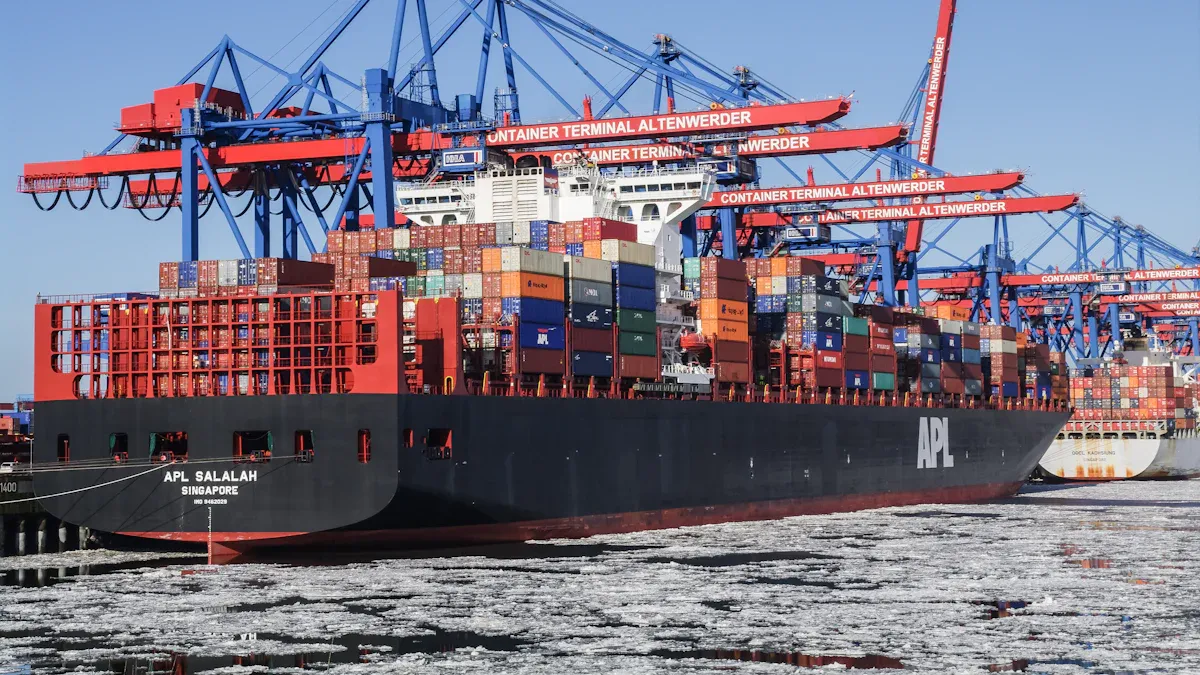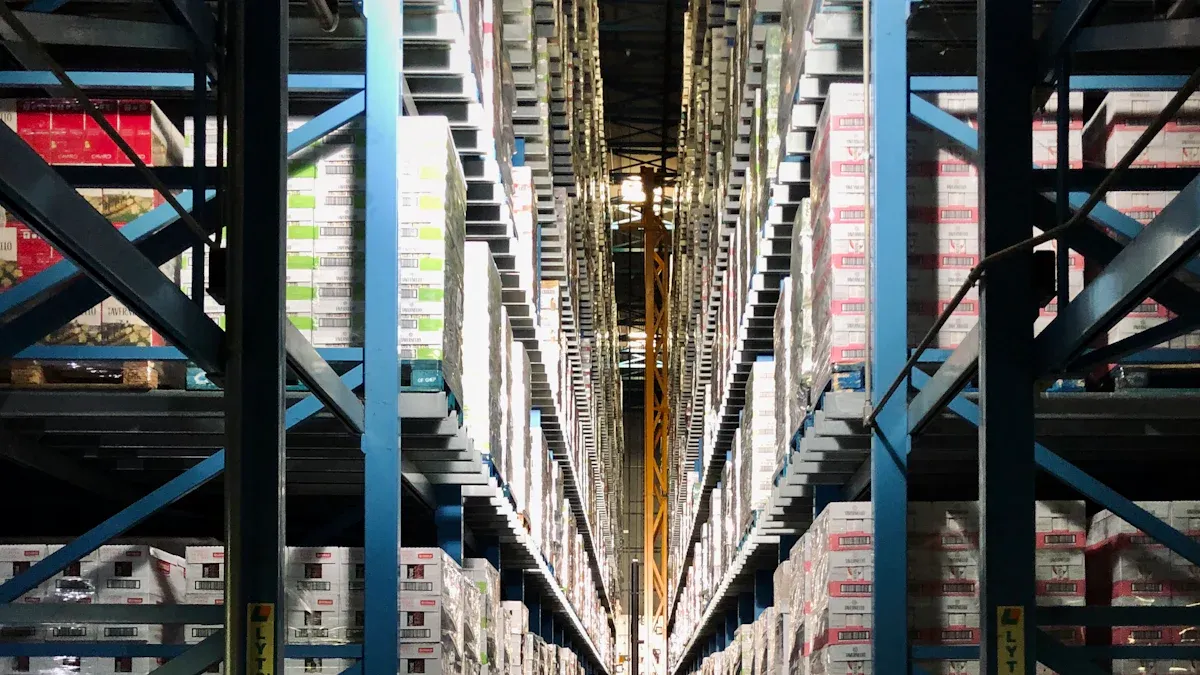The Role of WMS in Enhancing Cross-Border Logistics Efficiency in 2025

Efficient cross-border logistics are now crucial for global business success. Warehouse Management Systems (WMS) help simplify customs and regulations. Automation has significantly transformed the landscape. For example, eBay's translation tool helped exports to Latin America grow by 17.5% and trade value rise by 13.1%. This demonstrates how automation provides businesses with a competitive edge. JUSDA, with its JusTrade platform, is leading the way in cross-border logistics. It offers smart tools to expedite customs processes and enhance supply chains.
Key Takeaways
Warehouse Management Systems (WMS) simplify customs work, making shipping quicker and easier.
Automation lowers manual work, reducing mistakes by 80% and saving time and money.
Real-time tracking tools like JUSDA improve shipment visibility and prevent delays.
Picking a WMS that grows with your business is key to staying ahead globally.
Teaching workers how to use new WMS tools helps teams work better and faster.
Key Challenges in Cross-Border Logistics
Regulatory Compliance and Customs Complexities
Different trade rules and their effects
Understanding international trade rules is tough for businesses. Every country has its own rules, taxes, and paperwork. These differences make it harder to follow the rules and avoid mistakes. For example, businesses must meet specific customs paperwork needs. If they don’t, shipments can get delayed. Following the law keeps the supply chain safe but requires careful work.
Note: Following trade rules is important to keep shipments legal and avoid problems in cross-border logistics.
Problems from breaking trade rules
Not following customs rules can cause big problems. Delays at borders mess up delivery plans. Fines for breaking rules make costs go up. Long waits at borders also increase shipping costs. These delays make managing inventory harder and meeting customer needs tricky.
Fines for breaking rules raise expenses.
Inventory planning gets harder with shipping delays.
Operational Inefficiencies in Cross-Border Logistics
Disconnected systems and poor teamwork
Cross-border logistics often use systems that don’t work together. Containers waiting at ports waste time and show inefficiency. Poor teamwork between groups makes delays worse. These problems slow down the logistics process and hurt productivity.
High costs and slow work from manual tasks
Manual work slows down logistics and causes mistakes. For example, solving trade rule problems often needs manual work, which costs more. Better teamwork and automation can make things faster and cheaper.
Visibility and Tracking Limitations
No real-time tracking for shipments
Tracking shipments in real-time is very important. But bad infrastructure and supply chain issues make it hard. Strict checks, like Carta Porte rules, slow down shipments even more. These delays cost businesses money, especially in busy trade areas like the US-Mexico border.
Hard to manage delays without tracking
Without good tracking, managing delays is tough. Businesses can’t predict or fix delays, which leads to late deliveries. In 2023, trade between the US and Mexico was $798.83 billion. Border delays hurt both countries’ economies.
How WMS Solves Cross-Border Logistics Problems
Real-Time Tracking with JUSDA Tools
Watching shipments move across borders live
JUSDA's smart WMS tools let businesses track shipments live. Companies can see where their goods are at all times. This builds trust and reduces worries for everyone involved. For example, IoT devices help pinpoint the exact location of shipments.
Tip: Live tracking helps businesses deliver on time and work better.
Spotting and fixing delays early
Delays can mess up supply chains and cost more money. JUSDA's WMS uses data to predict delays before they happen. It warns businesses about risks so they can fix problems early. This keeps operations running smoothly and avoids big disruptions.
Automating Customs with JusTrade
Smarter customs clearance and paperwork
JusTrade makes customs paperwork faster by using automation. Businesses save time and make fewer mistakes, cutting errors by 20%. AI tools also lower supply chain problems by 22%. These features make cross-border shipping easier and quicker.
Faster processing with customs system links
JusTrade connects directly to customs systems worldwide. This speeds up shipment processing and cuts costs by 17%. Faster customs clearance helps companies stick to schedules and deliver on time.
Improving Efficiency with WMS
Simplifying tasks and reducing mistakes
WMS tools automate boring tasks, cutting mistakes by 80%. This makes operations more accurate and saves time. Businesses can focus on important work, like managing inventory better with alerts.
Centralized data for smarter choices
Modern WMS tools gather all data in one place. This helps businesses see problems and improve processes. Reports and analytics show where to make changes. The table below lists key WMS features that boost efficiency:
Feature | Description |
|---|---|
Multichannel integration | Handles orders, inventory, and shipping across platforms easily. |
Multilingual and multicurrency | Works with different languages and currencies for global markets. |
Inventory management | Tracks stock in real time and sends restock alerts. |
Customs and compliance | Automates paperwork and tracks rules for cross-border shipping. |
Shipping and logistics integration | Plans routes and creates shipping labels automatically. |
Reporting and analytics | Gives insights to fix problems and improve processes. |
Scalability and flexibility | Adjusts to growing orders and market changes. |
Security and compliance | Protects sensitive customer data and meets safety rules. |
Note: Centralized data helps teams work together and make better decisions.
Future Trends in WMS Technology for Cross-Border Logistics

AI-Driven Analytics and Predictive Tools
Predicting customs delays and optimizing routes
AI tools are changing cross-border logistics. They study traffic, weather, and demand to find better routes. Companies like Maersk use these tools to avoid problems. This saves money by changing shipping paths early. Digital twins, or virtual supply chain models, help test plans. They reduce delays and lower repair costs. Predictive tools also improve fleet use by cutting idle time.
Using data for better compliance
AI systems make following trade rules easier. They check regulations and spot risks. Predictive tools help businesses plan for demand changes. This avoids having too much or too little stock. Walmart uses these tools to restock faster and save money. Setting goals, like KPIs, helps measure success. These tools improve operations and follow customs rules better.
Blockchain for Secure and Transparent Transactions
Keeping customs documents safe
Blockchain keeps customs documents secure and clear. It creates records that can’t be changed. This makes checking documents easier and builds trust. Blockchain fixes problems with verifying data. It reduces mistakes and speeds up customs work.
Building trust and teamwork
Blockchain helps teams work together by sharing reliable data. Everyone involved can see the same information in real time. This improves decisions and teamwork. Blockchain keeps data safe from tampering. This is important for global trade and staying efficient.
IoT Integration for Enhanced Visibility
Tracking goods in real time
IoT devices help track shipments live. Sensors check conditions and equipment status. This gives better control over goods. Real-time tracking reduces delays and improves accuracy. IoT with machine learning predicts repairs and cuts downtime.
Managing inventory across borders
IoT makes inventory management easier. It automates data collection and reduces mistakes. Digital twins and IoT improve inventory at ports. The table below shows how IoT helps logistics:
Application Type | Description | Impact on Inventory Management |
|---|---|---|
Sensor Networks | Tracks conditions, equipment, and inventory movement | Gives better control over inventory |
Real-Time Tracking | Monitors location and worker activities | Makes inventory tracking more accurate |
Automated Data Collection | Gathers inventory data automatically | Reduces errors and boosts efficiency |
IoT helps businesses manage inventory better across borders. It cuts waste and keeps customers happy.
Actionable Insights for Businesses
Checking Your Current WMS Features
Finding missing automation and compliance tools
Businesses need to check their current WMS for weak spots. Manual tasks often cause mistakes and slow things down. This is especially true in cross-border shipping. Companies should see if their WMS can handle customs rules and automate tasks like paperwork. If the system can't do this, it may lead to delays and higher costs.
Seeing if it connects with customs and logistics systems
Good connections are key for smooth operations. A strong WMS should link with customs and logistics systems. For example, tools like JusTrade can speed up customs work and cut delays. Businesses should also check if their WMS allows live tracking and talks to carriers. These features improve tracking and make work easier.
Choosing Future-Ready WMS with JUSDA
Picking systems that grow and adjust
Future-ready WMS tools must grow with the business. They should handle more orders during busy times or expansion. Flexible systems, like JUSDA's, let companies adjust features for their industry. This helps businesses stay ahead in changing markets.
Working with vendors using advanced tech
Choosing the right vendor is very important. Companies should team up with providers like JUSDA, which offer smart tools like AI and IoT. These tools help businesses make better decisions and work faster. Vendors with experience in cross-border shipping can give custom solutions for unique problems.
Training and Managing Changes
Teaching teams to use new tools
Training helps workers learn new WMS tools and processes. Planned training programs fit different learning needs. Job-specific training focuses on roles like warehouse workers or managers. For example, Nature’s Best kept 97% of its staff during a WMS update by using good training plans. This also saved money and boosted work speed.
Making WMS upgrades easy to adopt
Managing changes is key to using new WMS tools successfully. Companies like Performance Bike increased picks per hour by 50-100 units with good training and planning. A strong change plan reduces problems and helps workers accept new systems. The table below shows helpful training methods:
Training Method | What It Does |
|---|---|
Planned Delivery | Fits different learning styles with careful planning. |
Role-Specific Training | Focuses on specific jobs, like pickers or managers. |
By focusing on training and managing changes, businesses can get the most out of their WMS and improve their operations.
Warehouse Management Systems (WMS) help solve cross-border logistics problems. They make work faster, cut mistakes, and give better tracking. Tools like JusTrade help businesses handle customs and improve supply chains. Using these tools brings big benefits, as shown below:
Metric | Improvement Range |
|---|---|
Work speed | |
Less inventory needed | 10-20% |
Better use of space | 15-25% |
Fewer mistakes | Up to 80% |
Companies should act quickly to stay ahead. Choosing smart WMS tools makes global trade easier and more successful.
FAQ
What does WMS do in cross-border logistics?
WMS makes logistics easier and faster. It tracks shipments live, reduces mistakes, and follows customs rules. By keeping all data in one place, it helps businesses work smarter and better across borders.
Tip: Strong WMS tools like JUSDA's can cut delays and save money.
How does JusTrade help with customs?
JusTrade uses smart AI tools to handle customs paperwork. It connects with customs systems worldwide to speed up the process. This lowers mistakes and keeps shipments moving without problems.
Note: JusTrade's smart system can save up to 17% of time.
Can WMS work with different languages and currencies?
Yes, modern WMS tools support many languages and currencies. This is important for global businesses. It helps with smooth communication and correct money handling in different countries.
How does IoT make WMS better?
IoT tools show where shipments are and their condition. This helps businesses track goods and manage stock better. IoT also predicts repairs, cutting downtime and keeping things running smoothly.
Why is blockchain useful for cross-border logistics?
Blockchain keeps records safe and clear. It protects customs documents and builds trust between partners. This technology also makes checking documents faster, reducing trade delays.
Emoji Insight: 🔒 Blockchain = Safe + Clear Records!
See Also
Transforming Logistics: The Role of AI in Supply Chains
Navigating the Future: Digital Innovations in Logistics
Enhancing Supply Chain Performance: Five Key Trends Ahead
Exploring Sea Freight Logistics: Innovations for 2024
Addressing Global Supply Chain Growth Challenges Effectively
